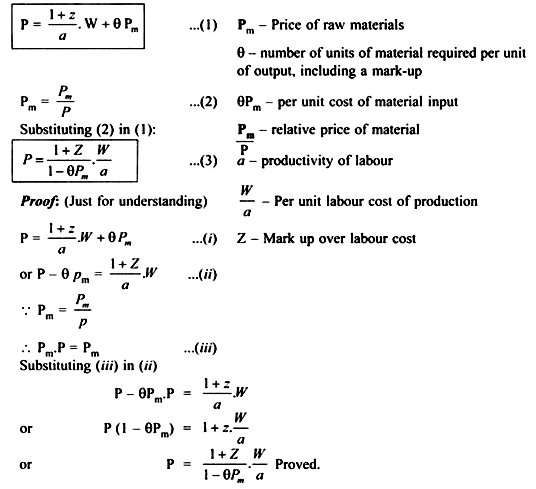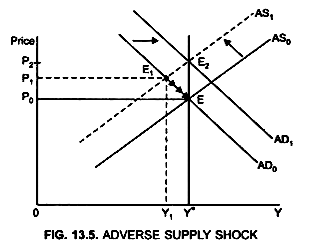Any change in the AD and the AS will lead to fluctuations in the economy as a whole. These changes are called shocks to the economy.
A supply shock is a disturbance to the economy whose first impact is a shift in the AS curve. Shock may be adverse or favourable. In a case of an adverse supply shock.
It will have 2 effect:
(i) Increase in P
ADVERTISEMENTS:
(ii) Decrease in the output level
e.g. Oil Price Shock. It is a case of adverse supply shock there is a sudden and significant rise in prices. An increase in the oil price implies an increase in the cost of production. As a result, firms will be willing to supply output only at a higher price. The AS curve will shift upwards to the left.
If we incorporate supply shock into AS curve by including price of raw materials then price (AS) equation will be written as:
Equation (3) shows that given the (a) wage (b) profit margin and (c) the labour productivity, an increase in the real price of materials will lead to an increase in the cost of production and thus in an increase in the price level.
Thus, AS curve will shift to the left.
Initially the economy is at full employment level (Y*) at point E
ADVERTISEMENTS:
Price level – P0.
Due to an adverse supply shock caused by an increase in the price of material (oil), at a given wage, AS curve shifts upwards to the left from AS0 to AS1 (Fig. 13.5).
Reason:
Increase in the cost of production.
Equilibrium of economy moves from point E to E1.
Immediate effect:
(i) Increase in the price level from P0 to P1 (P1 > P0)
(ii) Decrease in the output level from Y* to Y1 (Y1 < Y*)
(iii) Real wages will fall.
ADVERTISEMENTS:
As Y1 <Y*
Unemployment takes place because of decrease in the demand for labour.
Result: Wages will fall.
Increase in price level and fall in wages implies fall in:
ADVERTISEMENTS:
Real wages (W/P):
Due to decrease in real wage (W/P), on the one hand labour cost falls and on the other hand fall in real wage (W/P) will lead to a decrease in the AD, and thus the price level will fall. The adjustment continues till the economy does not come back to the same price level and full employment level as it was before the shock.
The economy moves from point E] to E and the full employment output level (Y*) is reached. This is called automatic adjustment process. Thus, an adverse supply shock gives dual blow to the economy, that is, higher price and low output level. There is thus inflation with recession known as stagflation. Increase in price is accompanied by higher unemployment. This leads to the break-down of Phillips curve.
How to accommodate a supply shock?
ADVERTISEMENTS:
As the automatic adjustment process is slow because wages adjust downward slowly, therefore the economy will have to tolerate prolonged recession. Thus, expansionary monetary and fiscal policies are used which will lead to an increase in AD and, thus can be used in case of adverse supply shock. Such policies which increase AD are called accommodating policies as it will prevent the price from falling. Price will rise by the full extent by which the AS curve shifts upwards.
In Fig. (13.5) Due to expansionary monetary and fiscal policy AD curve will shift to the right from AD0 to AD1. Equilibrium is attained at point E2, at a higher price level – P2 but at the full employment output level – Y*. However accommodating policies are not undertaken because of trade off between inflationary impact of supply shock and its recessionary effect.


